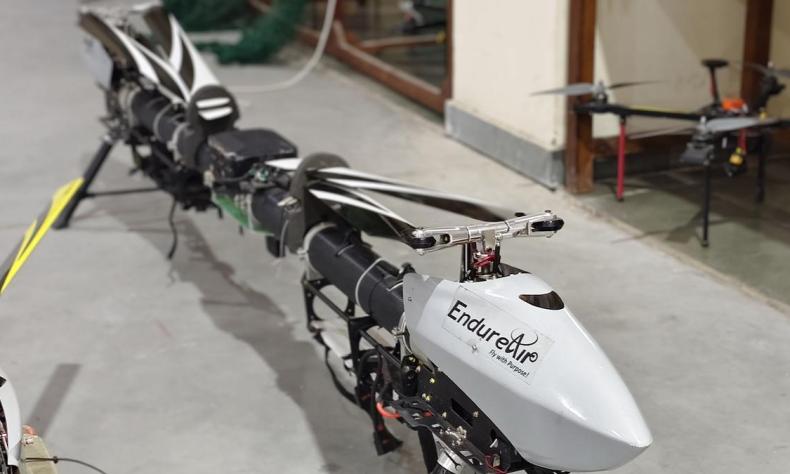
A drone developed by EndureAir using the tandem rotor technology of helicopters
An object can be airborne in two ways. It can move very fast so that there’s an air pressure difference between its flat lower and curved upper surface, giving it a lift. This is how an aeroplane flies. Or it can get airborne by pushing air downwards, like a helicopter. It is basic aerodynamics that you can have one or the other, not both. That’s why we don’t have large aircraft taking off vertically, or helicopters carrying hundreds of passengers.
But when it comes to drones, there are ways of cheating aerodynamics. Two startups incubated at IIT-Kanpur have come up with innovative drone designs. Neither is a new concept, but involves fine-tuning for specific applications.
VU Dynamics, a company that has been acquired by Indore-based Prakash Asphaltings & Toll Highways (India) Limited, has developed catapult-launched fixed-wing kamikaze drones (that crash into enemy assets).
The drones are flung skyward by catapult systems developed by the company; once in the air, their engines take over. The technology has been tried before, for instance, in the aborted ‘Nishant UAV’ project of the Defence Research and Development Organisation. However, with drones staging a comeback in recent times, there are quite a few catapult-launched fixed-wing drones in India, including Alpha Defense’s Sky Striker, which was used to strike targets in Pakistan.
VU Dynamics has developed two variants, with differences in range, warhead capacity, launch weight, and communications radius.
Incidentally, the company has also developed rotary-wing drones that can lob a grenade on enemy territory.
Another startup, EndureAir, founded by Prof Abhishek and his students, has developed rotary drones that resemble a miniaturised US Chinook helicopter. With a tandem rotor configuration, the two rotors on either end spin in opposite directions (clockwise and anticlockwise), giving a higher ‘lift’. Tandem rotor is essentially a helicopter concept. EndureAir’s tandem rotor drones come in two variants — Sabal 20 and Sabal 40; the numbers indicate the payload capacity in kg. They are meant for defence logistics.
The company has also developed a tilt-rotor drone, where four rotors, after vertical lift-off, tilt from a vertical axis to a horizontal axis. We have seen such aircraft in the Arnold Schwarzenegger movie True Lies.
In EndureAir’s hybrid (fixed-plus-rotary) drones, the four rotors stand on two fixed wings and provide vertical lift-off. Once in flight, the rotors tilt — from skyward to the direction of flight — to function as propellers, and the drone resembles a small biplane.
Abhishek is working on drones that can land on moving objects like ships and trucks.
Helicopters can land on moving ships, but they are manned. To land an autonomous drone on a moving ship calls for computer vision and AI — the drone ‘observes’ the marked landing point for about 5 seconds and lowers itself on it. The ‘proof of concept’ has been done; the product is under development.
Both Abhishek and Prof Subrahmanyam Saderla, founder of VU Dynamics, told Quantum that it is no big deal for India to develop large drones, such as the Turkish Bayraktar TB-2 drones, if off-take is assured.
More Like This
Published on May 18, 2025
This article first appeared on The Hindu Business Line
📰 Crime Today News is proudly sponsored by DRYFRUIT & CO – A Brand by eFabby Global LLC
Design & Developed by Yes Mom Hosting






